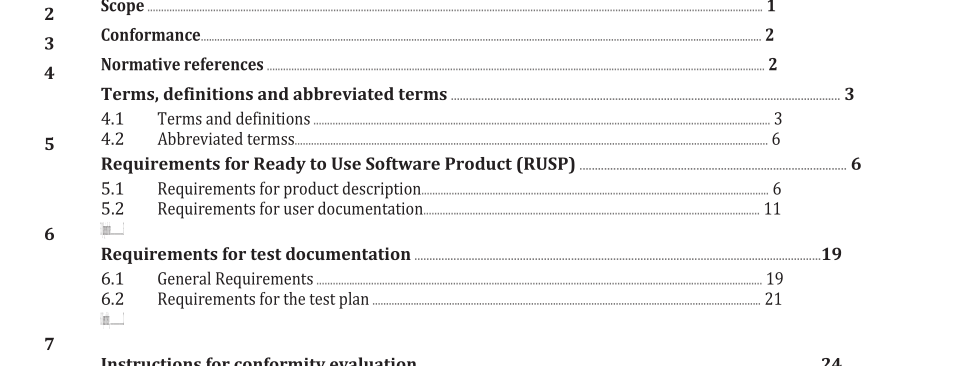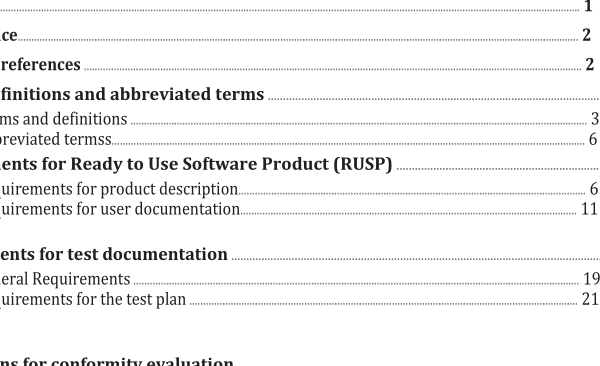ISO IEC 25051:2014 pdf download – Software engineering — Systems and software Quality Requirements and Evaluation (SQuaRE) — Requirements for quality of Ready to Use Software Product (RUSP) and instructions for testing.
4?Terms,?definitions?and?abbreviated?terms 4.1?Terms?and?definitions For the purposes of this document, the following terms and definitions apply: 4.1.1 acquirer stakeholder that acquires or procures a product or service from a supplier Note 1 to entry: The acquirer could be one of the following: buyer, customer, owner, purchaser. [SOURCE: ISO/IEC 12207:2008] 4.1.2 anomaly any condition that deviates from expectations based on requirements specifications, design documents, standards, etc. or from someone’s perceptions or experiences [SOURCE: IEEE Std 1044-2009] 4.1.3 application administration function functions performed by users which include installation, configuration, application backup, maintenance (patching and upgrading) and uninstallation 4.1.4 conformity evaluation systematic examination of the extent to which a product, process or service fulfils specified requirements [SOURCE: ISO/IEC Guide 2:2004] 4.1.5 conformity evaluation report document that describes the conduct and results of the evaluation carried out for a Ready to Use Software Product (RUSP) Note 1 to entry: This was adapted from IEEE Std 610.12–1990. 4.1.6 Ready to Use Software Product RUSP software product available for any user, at cost or not, and use without the need to conduct development activities Note 1 to entry: Ready to Use Software Product (RUSP) includes: — the product description (including all cover information, data sheet, website information, etc.), — the user documentation (necessary to install and use the software), including any configurations of the operating system/s or target computer required to operate the product, — the software contained on a computer sensible media (disk, CD-ROM, internet downloadable, etc.). Note 2 to entry: Software is mainly composed of programs and data. Note 3 to entry: This definition applies also to product description, user documentation and software which are produced and supported as separate manufactured goods, but for which typical commercial fees and licensing considerations may not apply.
4.1.7 end user individual person who ultimately benefits from the Ready to Use Software Product functionalities Note 1 to entry: The end user may be a regular operator of the software product or a casual user such as a member of the public. [SOURCE: ISO/IEC 25000:2005] 4.1.8 fault incorrect step, process, or data definition in a computer program [SOURCE: IEEE Std 610.12-1990] 4.1.9 maintenance process of modifying a software system or component after delivery to correct faults, improve performance or others attributes, or adapt to a changed environment [SOURCE: IEEE Std 610.12-1990] 4.1.10 pass/fail criteria decision rules used to determine whether a software item or a software feature passes or fails a test [SOURCE: IEEE Std 829.12-1998] 4.1.11 product description document stating properties of software, with the main purpose of helping potential acquirers in the evaluation of the suitability for themselves of the software before purchasing it 4.1.12 product?identification software product name, version, variant, and date information
ISO IEC 25051:2014 pdf download – Software engineering — Systems and software Quality Requirements and Evaluation (SQuaRE) — Requirements for quality of Ready to Use Software Product (RUSP) and instructions for testing






